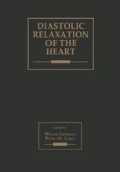Abstract
Initially during myocardial hypoxia or ischemia, development of contractile force declines. Ultimately the myocardial cell fails completely to develop contractile force and is usually fully relaxed at this stage [1]. With continued impairment of adenosine triphosphate (ATP) synthesis, the ischemic myocardial cell begins to develop an increase in resting tension. This increase in resting tension could be due to a rise in cytosolic free Ca2+ ion concentration, [Ca2+]i, or a fall in ATP concentration, which could produce rigor due to failure of actin-myosin cross-bridge dissociation [2].
Access this chapter
Tax calculation will be finalised at checkout
Purchases are for personal use only
Preview
Unable to display preview. Download preview PDF.
References
Nayler WG, Poole-Wilson PA, Williams A (1979). Hypoxia and calcium. J Mol Cell Cardiol 11: 683–706.
Grossman W, Barry WH (1980). Diastolic pressure-volume relations in the diseased heart. Fed Proc 39: 148–155.
Lewis MJ, Housmans PR, Claes VA, Brutsaert DL, Henderson AH (1980). Myocardial stiffness during hypoxic and reoxygenation contracture. Cardiovasc Res 14: 339–344.
Holubarsch CL, Alpert NR, Goulette R, Mulieri LA (1982). Heat production during hypoxic contracture of rat myocardium. Circ Res 51: 777–786.
Allen DG, Orchard CH (1983). Intracellular calcium concentration during hypoxia and metabolic inhibition in mammalian ventricular muscle. J Physiol (Lond) 339: 107–122.
Cobbold PH, Bourne PK (1984). Aequorin measurements of free calcium in single heart cells. Nature 312: 444–446.
Dahl G, Isenberg G (1980). Decoupling of heart muscle cells: Correlation with increased cytoplasmic calcium activity and with changes of nexus ultrastructure. J Memb Biol 53: C3–75.
Wojtczak J (1979). Contractures and increase in internal longitudinal resistance of cow ventricular muscle induced by hypoxia. Circ Res 44: 88–95.
Murphy E, Jacob R, Lieberman M (1985). Cytosolic free calcium in chick heart cells. J Mol Cell Cardiol 17: 221–231.
Snowdowne KW, Ertel RJ, Borle AB (1985). Measurement of cytosolic calcium with aequorin in dispersed rat ventricular cells. J Mol Cell Cardiol 17: 233–241.
Clusin WT (1985). Do caffeine and metabolic inhibitors increase free calcium in the heart? Interpretation of conflicting intracellular calcium measurements. J Mol Cell Cardiol 17: 213–220.
Chapman RA (1986). Sodium/calcium exchange and intracellular calcium buffering in ferret myocardium: An ion-sensitive microelectrode study. J Physiol (Loud) 373: 163–179.
Barry WH, Pober J, Marsh JD, et al (1980). Effects of graded hypoxia on contraction of cultured chick embryo ventricular cells. Am J Physiol 239: H651 - H657.
Barry WH, Rasmussen CAF Jr, Ishida H, Bridge JHB (1986). External Na-independent Ca extrusion in cultured ventricular cells. J Gen Physiol 88: 393–411.
Grynkiewicz G, Poenie M, Tsien RY (1985). A new generation of Ca’ indicators with greatly improved fluorescence properties. J Biol Chem 2650: 3440–3450.
Peeters GA, Hlady V, Bridge JHB, Barry WH (1987). Simultaneous measurements of calcium transients and cell motion in cultured heart cells. Am J Physiol, in press.
Hasin Y, Doorey A, Barry WH (1984). Effects of calcium flux inhibitors on contracture and calcium content during inhibition of high energy phosphate production in cultured heart cells. J Mol Cell Cardiol 16: 823–834.
Hasin Y, Barry WH (1984). Myocardial metabolic inhibition and membrane potential, contraction, and potassium uptake. Am J Physiol 247: H322 - H329.
Reeves JP, Hale CC (1984). Stoichiometry of the cardiac Na-Ca exchange system. J Biol Chem 259: 7733–7739.
Doorey AJ, Barry WH (1983). The effects of inhibition of oxidative phosphorylation and glycolysis on contractility and high energy phosphate content in cultured chick heart cells. Circ Res 53: 192–201.
Cunningham MJ, Rasmussen CAF Jr, Sheck R, Barry WH (1985). Energy deprivation contracture in zero Na: Effects of resupply of Na or resynthesis of ATP on relaxation. Circulation. 72: III - 345 (abstract).
Conrad CH, Brooks WW, Ingwall JS, Bing OHL (1984). Inhibition of hypoxic myocardial contracture by cobalt in the rat. J Mol Cell Cardiol 16: 347–354.
Renlund D, Gerstenblith G, Lakatta E, et al (1984). Perfusate sodium during ischemia-modified postischemic functional and metabolic recovery in the rabbit heart. J Mol Cell Cardiol 16: 795–801.
Editor information
Editors and Affiliations
Rights and permissions
Copyright information
© 1987 Martinus Nijhoff Publishing
About this chapter
Cite this chapter
Barry, W.H. (1987). Is Ischemic Contracture Preceded by a Rise in Free Calcium?. In: Grossman, W., Lorell, B.H. (eds) Diastolic Relaxation of the Heart. Springer, Boston, MA. https://doi.org/10.1007/978-1-4615-6832-2_5
Download citation
DOI: https://doi.org/10.1007/978-1-4615-6832-2_5
Publisher Name: Springer, Boston, MA
Print ISBN: 978-1-4615-6834-6
Online ISBN: 978-1-4615-6832-2
eBook Packages: Springer Book Archive

